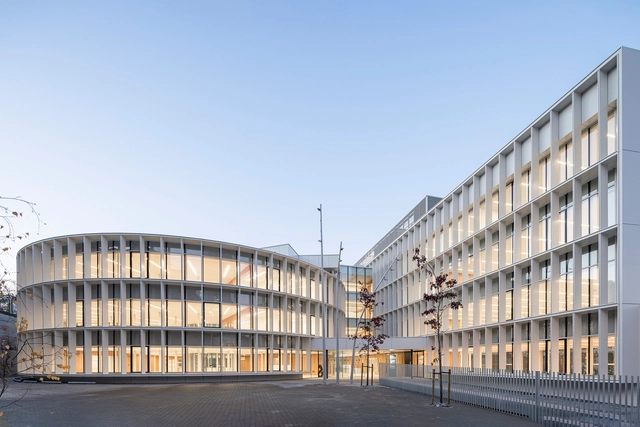
Enhancing the energy performance of existing buildings through refurbishment processes provides the opportunity to create more comfortable and sustainable environments, while also improving their functionality, aesthetics, and safety. Architectural approaches to these renovations encompass various aspects of a building, including interior spaces, structure, internal systems, and facades.
When it comes to rethinking a building's envelope, STACBOND’s composite panel solutions delve into the development of ventilated facades. These facade systems serve as an architectural strategy for energy-efficient building renovations. Minimizing energy consumption for heating and cooling, the rehabilitation strategy incorporates thermal insulation, moisture management, and thermal mass optimization.
How does a ventilated facade system work?
Ventilated facades, comprising key components such as anchors, an insulating layer, an external leaf, and crowning elements, seamlessly integrate to form a highly efficient and functional structure for exterior enclosures. Anchors secure spaces on the interior leaf and prevent facade collapse. Profiles are attached to these anchors for support assemblies, while the insulating layer enhances thermal and acoustic insulation. Responsible for the chimney effect, the external leaf separates interior and exterior environments, safeguarding the original facade during rehabilitation projects. On top of the ventilated facade, the crown blocks water and allows ventilation.
The system enables an insulating layer together with an outer leaf to be placed on top of an inner leaf, all through a supporting metal structure. At the same time, the design strategy creates a gap between these layers for airflow, generating natural ventilation known as the “chimney effect”. Its primary purpose is to moderate the exchange of heat and air, as well as light that circulates between the building’s interior and exterior.

Besides their energy savings due to their chimney effect, ventilated facade systems offer various advantages in terms of habitability and construction. They reduce thermal jumps, avoid humidity and thermal bridges, and lighten the building envelope. Meanwhile, the use of lightweight materials (such as aluminum) for the anchored exterior cladding facilitates transportation, installation, and long-term maintenance.

By replacing worn-out or deficient materials with these technologies, architects and designers can achieve outstanding acoustic and thermal insulation, positively impacting the sustainability of any construction project. In fact, ventilated facades can ultimately result in an estimated energy saving of 30%.
Why use aluminum composite panels for ventilated facades?
The exploration of ventilated facade as building envelopes has led to different material solutions, from wood and ceramics to composites. STACBOND’s aluminum composite panel (ACP) is a material composed of two aluminum sheets and an inner mineral filler core. With excellent mechanical properties, the ACP incorporates flexural rigidity with reduced weight, surface flatness, durability, and ease of maintenance. Being a recyclable material, it contributes to minimizing the architecture project’s environmental impact.
In a wide range of colors, brightness, textures, and natural finishes, these ACP systems adapt to various architectural contexts, including new constructions and renovations of ventilated facades. Exemplifying their numerous potential applications, the rehabilitation of Espazo Amisar, a governmental building located in A Coruña, Spain, showcases how ventilated facades can give buildings a new life.

Espazo Amizar: boosting energy efficiency with ventilated facades
The former Provincial Health Delegation of A Coruña, built in 1971, was transformed into a new complex for the offices of the Equality and Employment Council. The overall strategy of Vazques Muiño Architects' project included external urbanization, public areas, as well as changes in the installations, roofs, interior layouts, and the design of a new building envelope.

The rehabilitation process revitalized the entire complex, resulting in a renewed, functional, and durable volume. Contemporary materials and construction systems were utilized to enhance aesthetics, giving the building a distinctive institutional character.
In a Grey white finish, the aluminum composite panel ensures minimal overload on the building structure while guaranteeing resistance to the passage of time and various climatic conditions. The ventilated ACP facades maximize energy savings and ensure easy maintenance and adaptability to the existing structure.


The new facade is built using STACBOND FR composite panels, consisting of two aluminum sheets, together with an inner fire-retardant core of thermoplastic resins with mineral charge. Besides its mechanical properties (high impact resistance and dimensional stability), it complies with the majority of requirements for fire resistance classifications.

With an array of construction and installation systems for composite panels, there is greater adaptability to the specific needs of each architectural facade, optimizing solutions, finishes, and costs. The rehabilitation makes use of the STB-CH system, which employs hanging cassettes from the composite panel for the assembly of the ventilated facade. While being a hidden fixing system, it has a versatile configuration with either vertical or horizontal modulations.
For more information on aluminum composite panels and how to apply them, visit our product catalog.
















